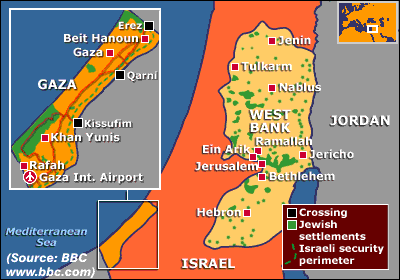 Map of Israel showing Palestinian territories and lines of demarcation |
The question of Palestine and Israel has commanded the attention of the UN since the organization was founded. The UN General Assembly voted the original partition of the land in November 1947 and the UN deployed its first peacekeeping operation to monitor the ceasefire lines after the war of 1948. This site introduces readers to the key issues, with a special focus on UN involvement in the conflict.
For many years, successive Israeli governments refused to consider a Palestinian state, while most Arabs denied the legitimacy of Israel. In the 1970s both sides began to recognize the need for compromise. The Palestinians proposed a separate state, claiming as their homeland the territories outside the 1948 ceasefire lines, territories occupied by Israel in the 1967 war. This idea found widespread support in the international community, and Israel was called on to withdraw from this land, as affirmed in UN Security Council Resolutions 242 and 338.
Israel's 1967 occupation of other territories complicated the matter. Israel seized Egypt's Sinai Peninsula and Syria's Golan Heights and set up settlements in both. Israel also invaded Lebanon in 1978 and 1982 and maintained a long-term occupation in the southern part of the country. These wars and occupations were related to the Palestine question and deepened the political crisis surrounding it. Even after Israel eventually withdrew from Egypt and Lebanon, the Palestine (and Golan) occupations continued. Israel's settlement-building, and its construction of a massive border-wall that annexed large swaths of Palestinian territory, has made resolution of the conflict far more difficult.
Since resolutions 242 and 338, the Security Council has taken no significant steps to end the Israel-Palestine conflict. United States influence has generally kept the issue off the Council's agenda. When Council members have introduced resolutions, responding to periodic crises, the US has repeatedly used symbolic weight. Both bodies would have been more effective if governments had been willing to confront US displeasure and US pressure. Recent US policy has only made matters worse.
Key issues that have plagued the stalled "peace process" include: Israel's occupation, Israeli settlements and settlement-building, the Israeli wall, security for Israelis and Palestinians, shared sovereignty over Jerusalem, and the right of return of 3.7 million stateless Palestinian refugees.
Palestinian Statehood: The UN and Beyond
This page provides a selection of reports, articles and op-eds on the question of Palestinian statehood, and provides context for Palestine's expected membership bid at the UN during the 2011 General Assembly.
Documents
This page provides key UN documents as well as major documents related to the peace process.
UN Involvement
The United Nations has not been able to resolve the Israel-Palestine conflict. The Security Council has been sidelined by US pressure and vetoes. The General Assembly has taken a more active role, though its resolutions have only moral and symbolic weight. The UN acts today primarily through its role as a member of the "Quartet."
Peace Process
This page looks at various attempts to end the Israel/Palestine conflict, such as the Annapolis Conference, the Geneva Accord, the Road Map, the Saudi peace plan, the Oslo Accords and it posts other general articles on negotiations towards peace.
Refugee Right of Return
This page provides documents and analyses of the right of return guaranteed to Palestinians by UN General Assembly Resolution 194. This right is clearly and unambiguously guaranteed in international law. Any lasting settlement must find a solution that provides citizenship and a secure home for the 3.7 million Palestinian refugees.
Land and Settlement Issues
At the heart of the Israel/Palestine conflict today lies the question of the Palestinian territories occupied by Israel since the war of 1967, which include the West Bank, Gaza Strip and East Jerusalem. Continuing Israeli occupation, creation of Jewish settlements and construction of the "security fence" block the path to peace. This page provides analyses and maps of the occupation and territorial disputes.
General Analysis
This page provides a general analysis on the Israel-Palestine conflict.
Links and Resources
This page provides useful links and resources on the Israel/Palestine conflict.

